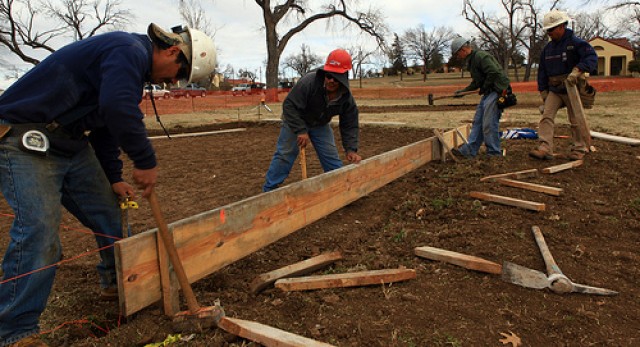
FORT SILL, Okla. -- In 1897, the French military had a secret weapon. It was an artillery gun that had a hydro-pneumatic recoil mechanism which allowed it to stay in battery after it been fired. Cannoneers didn't have to re-aim the gun and so it could be fired again very quickly. It was revolutionary.
It was the French 75 mm field gun, and it will be one of the field artillery weapons displayed at the new Artillery Park.
Construction is under way for the park which will take visitors through a timeline of domestic and foreign field artillery beginning in the 19th century to modern day. The park is alongside the Fort Sill Field Artillery Museum and replaces the Cannon Walk exhibit.
Groundwork began in mid-January, and museum officials said they expect the block-long park to open sometime in 2011.
Artillery Park will allow the exhibition of huge artillery that will not fit in the museum as well as duplicate artifacts and will provide a storyline of the development of field artillery that can educate museum visitors as well as artillerymen training here, said Towana Spivey, director and curator of the Fort Sill Museum.
Once completed, Artillery Park will showcase about 100 pieces of vintage field artillery in a user-friendly park with wide sidewalks, lighting and easy access to the FA Museum, Spivey said. The park is off Lubberman Road between Randolph and Geronimo roads.
Spivey began the research and design work for an artillery park project in 1995.Those ideas were made into blueprints in 1998, and then the process to seek funding for the new park began, Spivey said. Funding was received in 2009.
"It's the culmination of a project that we planned a long time ago to give more attention to the historic field artillery in our collection," Spivey said.
The plan was to put artillery which had pristine original paint or patina (oxidized finish) indoors and to put others outside either because they were too large or to become part of a storyline interpretation, he said.
The museum had accumulated many foreign artillery pieces over the years as war trophies and Spivey wanted those to be exhibited, too.
"I combined the foreign and the domestic artillery into a storyline ... it's a chronological sequence and it's also a technological sequence," Spivey said.
The earliest display will be the French 75 mm field gun, Spivey said. In 1917, Soldiers at Fort Sill trained on it before they were deployed to Europe during World War I.
The ending display will be an XM2001 Crusader self-propelled howitzer prototype from 2001, which was never adopted by the U.S. military, Spivey said.
Many of the artillery pieces will be displayed in emplacements - or the context where it was used, whether it was World War I or II, Korea, Vietnam, etc., he said.
"You can see the weapon in the way that it was used in combat," Spivey said.
The park was designed to be an enjoyable experience for everyone, he said.
"Looking at a hundred artillery pieces can be boring to some people, and it can be an enlightening experience to others."
He designed the park with walkways where visitors can cut across the huge loop and go to rest sites.
Having Artillery Park right next to the U.S. Army Field Artillery Museum will make it convenient for visitors, said Gordon Blaker, director and curator of the Field Artillery Museum.
There is still a lot of work to do before the park will open, Blaker said.
"I've got a lot of moving (of artillery) to do and I've also got a lot of restoration to do and that is an extremely slow process," he said.

Social Sharing